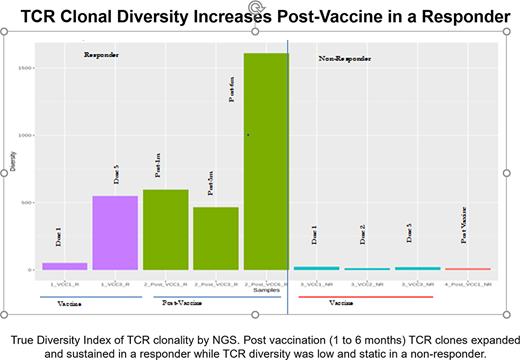Introduction
Our group has pioneered a personalized vaccine in which patient-derived acute myeloid leukemia (AML) cells are fused with autologous dendritic cells (DC/AML fusion), presenting a broad array of leukemia associated antigens with DC mediated costimulation. In a clinical trial of AML patients who were vaccinated after chemotherapy-induced remission, 71% remained free of disease at median follow up of 57 months. We sought to identify factors associated with durable remission after vaccination using genomic analysis of the bone marrow microenvironment including single cell RNA-seq and TCR clonal diversity analysis.
Methods
Banked bone marrow samples both prior to and 1 month post-vaccination were selected from patients who maintained long disease remission for greater than 5 years and those who had early relapse. FFPE marrow core biopsy samples (N=10) were the source for gene expression analysis. NEBNext ultra II directional library prep kit and Illumina NextSeq 500/550 system were used to generate reliable high quality RNA sequencing data. Differentially expressed genes were identified by p-value (≤0.01) and fold change (≥2) using Linear Models for Microarray (Limma) approach. Ingenuity Pathways IPA 9.0 was then used to define pathways and upstream regulators. Flash frozen samples (N=4) were analyzed by RNAseq at the single cell level using a standard 10X genomics approach with cell cluster annotation performed with Single Cell Wizard software. Banked peripheral blood was used to evaluate TCR diversity with Takara SMART-Seq next-generation sequencing to amplify variable regions of TCR- α/β subunits.
Results
Heatmaps depict significant differential gene expression in bone marrow biopsies both pre- and post-vaccination in patients who remained in long-term remission (responders) compared to those who relapsed (non-responders). Prior to vaccination there was modest upregulation of immune activation pathways including IL-7, IL-17A as well as inhibition of TGF-b in responders, suggesting a role of the micro-environment in modulating response. Significantly upregulated pathways in responders after vaccination (p value <0.01) were related to immune activation including NO and Reactive Oxygen Species in Macrophages, IL-2, IL-15, IL-6, IL-7,IL17A, and B cell activation. TGF-b was also downregulated in responders post-vaccination.
To characterize the cellular components of the immune micro-environment, single cell analysis was assessed in bone marrow aspirates both pre- and post-vaccination (N=2). Increased cellular heterogeneity pre-vaccination, and increases in T and NK populations post-vaccination, were noted in responding patients who had durable remissions. Furthermore, the temporal changes in expression of TCR clonotypes showed an increase in TCR diversity post-vaccination (N=2). Of note, a patient who achieved a durable remission had (i) loss of specific clonal populations present at the time of diagnosis and (ii) the emergence of newly expanded TCR signatures that were further expanded with subsequent vaccinations and remained present during the follow up period. In contrast, the TCR diversity in a non-responder was low and static with no difference in the TCR clonotypes after vaccination.
Conclusions
In a cohort of AML patients vaccinated after chemotherapy-induced remission, we found distinct gene signatures amongst patients with long term response as compared to those with early relapse. These signatures have potential to serve as predictive and early biomarkers of vaccine response, and will be investigated in a larger cohort from an ongoing trial. The transcriptomes indicate that vaccine response is dependent on a robust immune microenvironment, as characterized by upregulation of cytokines, activation of T cells, B cells and macrophages, and reduction of TGF-b-mediated negative immunoregulation. We also found that vaccine response is associated with durable oligoclonal expansion within the T cell repertoire, which purportedly represent functionally potent anti-AML shared- and neo-antigen specific T cell populations. This provides an especially unique opportunity to identify target antigens by TCR-epitope pairing. Indeed, information regarding AML antigens targeted by the immune system in the induction of durable remissions could further advance the field of AML treatment by integration in combinatorial therapeutic strategies.
Stone:Roche: Consultancy; Arog: Consultancy, Research Funding; Novartis: Consultancy, Research Funding; Stemline: Consultancy; Takeda: Other: DSMB; Agios: Consultancy, Research Funding; Astra-Zeneca: Consultancy; Macrogenics: Consultancy; Argenix: Other: DSMB; Arog: Consultancy, Research Funding; Biolinerx: Consultancy; Astellas: Consultancy; Daiichi-Sankyo: Consultancy; Celgene: Consultancy, Other: DSMB; Jazz: Consultancy; Abbvie: Consultancy, Research Funding; Trovagene: Consultancy; Biosight: Consultancy; Pfizer: Consultancy; Otsuka: Consultancy; Pfizer: Consultancy; Trovagene: Consultancy; Stemline: Consultancy; Jazz: Consultancy; Actinium: Membership on an entity's Board of Directors or advisory committees; Amgen: Membership on an entity's Board of Directors or advisory committees; Biolinerx: Consultancy; Biosight: Consultancy; Novartis: Consultancy, Research Funding; Astra-Zeneca: Consultancy; Abbvie: Consultancy, Research Funding; Biolinerx: Consultancy; Agios: Consultancy, Research Funding; Roche: Consultancy; Macrogenics: Consultancy; Trovagene: Consultancy; Argenix: Other: DSMB; Argenix: Other: DSMB; Otsuka: Consultancy; Takeda: Other: DSMB. Kufe:Genus Oncology: Equity Ownership; Reata Pharmaceuticals: Consultancy, Equity Ownership, Honoraria; Nanogen Therapeutics: Equity Ownership, Membership on an entity's Board of Directors or advisory committees; Victa BioTherapeutics: Consultancy, Equity Ownership, Honoraria, Membership on an entity's Board of Directors or advisory committees; Canbas: Consultancy, Honoraria; Hillstream BioPharma: Equity Ownership. Avigan:Takeda: Consultancy; Parexel: Consultancy; Celgene: Membership on an entity's Board of Directors or advisory committees, Research Funding; Pharmacyclics: Research Funding; Juno: Membership on an entity's Board of Directors or advisory committees; Partners Tx: Membership on an entity's Board of Directors or advisory committees; Partner Tx: Membership on an entity's Board of Directors or advisory committees; Karyopharm: Membership on an entity's Board of Directors or advisory committees; Bristol-Myers Squibb: Membership on an entity's Board of Directors or advisory committees; Janssen: Consultancy. Rosenblatt:Partner Tx: Other: Advisory Board; Dava Oncology: Other: Education; Parexel: Consultancy; BMS: Other: Advisory Board ; Merck: Other: Advisory Board; Amgen: Other: Advisory Board; BMS: Research Funding; Celgene: Research Funding; Imaging Endpoint: Consultancy.
Author notes
Asterisk with author names denotes non-ASH members.


